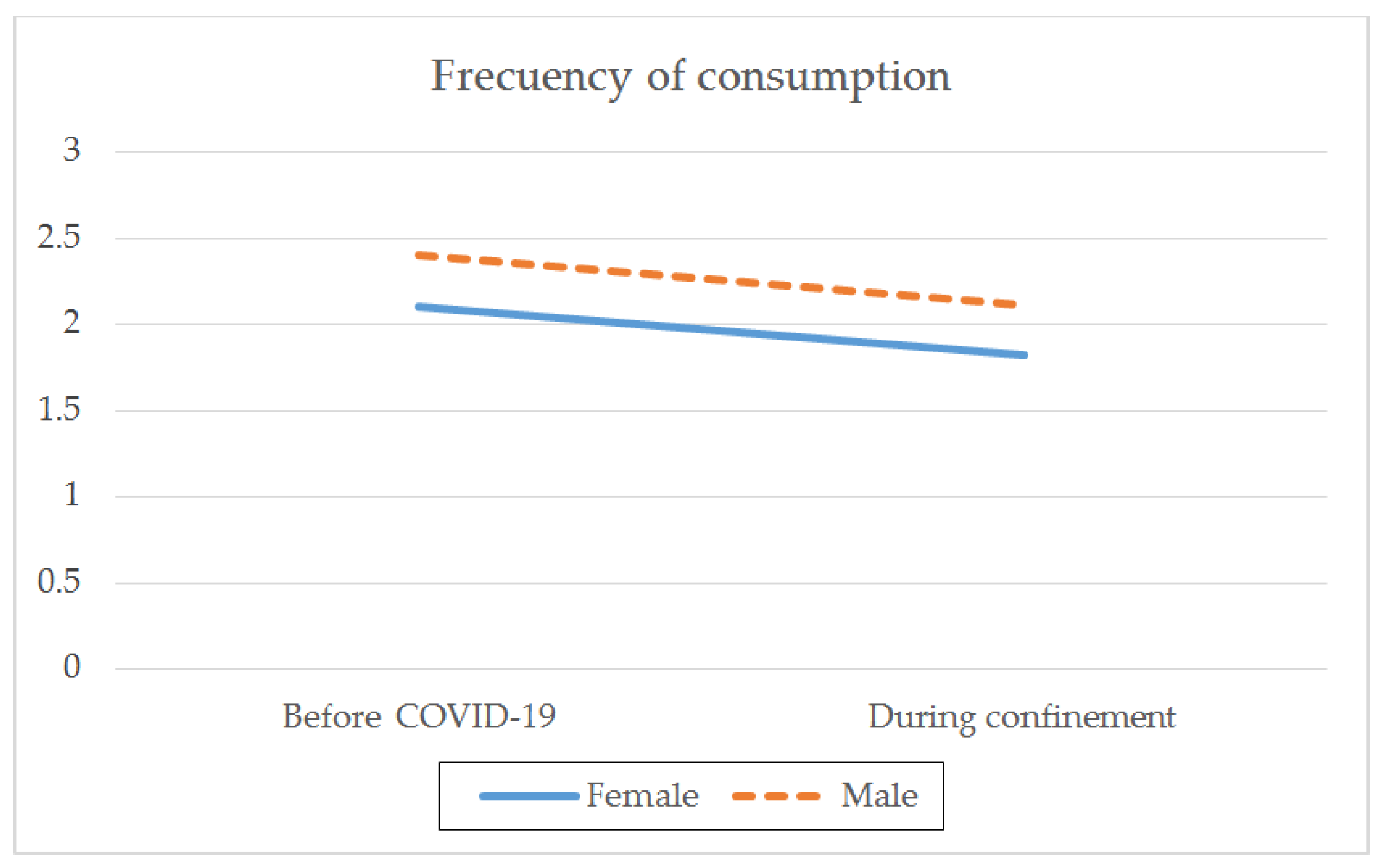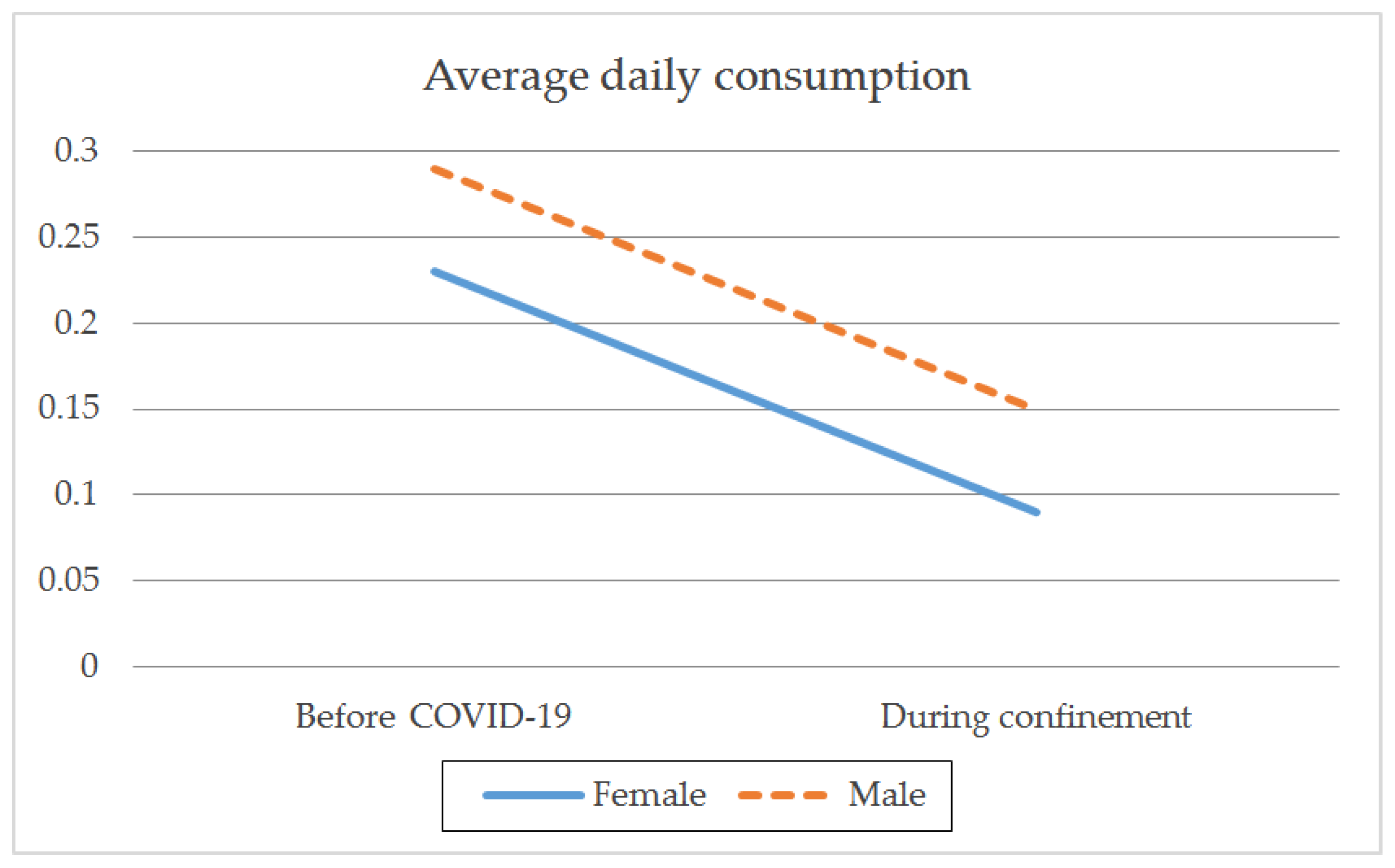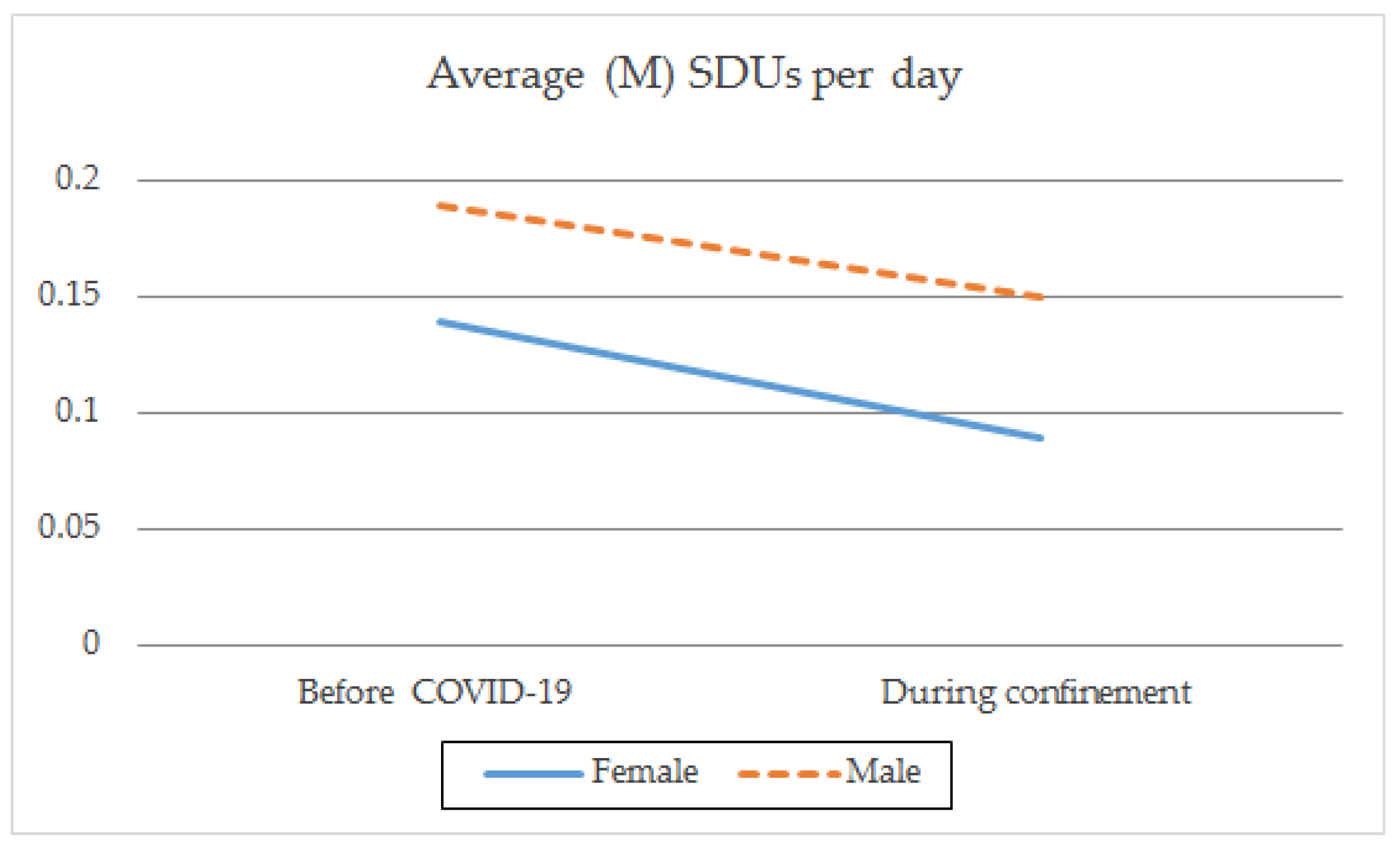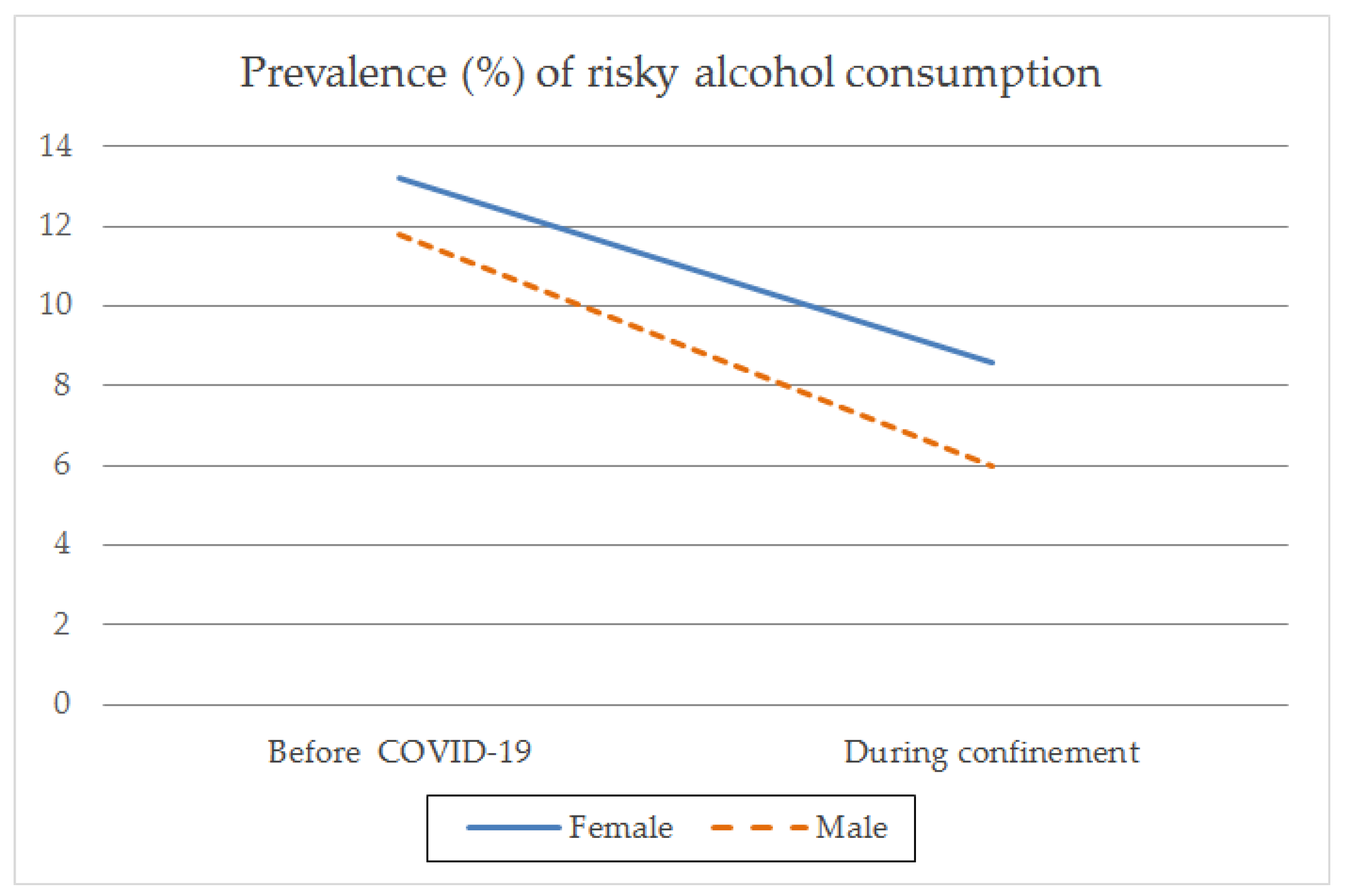Changes in Alcohol Consumption Pattern Based on Gender during COVID-19 Confinement in Spain
Abstract
:1. Introduction
2. Materials and Methods
2.1. Design
2.2. Population
2.3. Procedure
2.4. Study Variables
2.5. Statistical Analysis
2.6. Ethical Aspects
3. Results
4. Discussion
5. Conclusions
Author Contributions
Funding
Institutional Review Board Statement
Informed Consent Statement
Conflicts of Interest
References
- Chodkiewicz, J.; Talarowska, M.; Miniszewska, J.; Nawrock, N.; Bilinski, P. Alcohol consumption reported during the COVID-19 pandemic: The initial stage. Int. J. Environ. Res. Public Health 2020, 17, 4677. [Google Scholar] [CrossRef]
- De Agricultura, M.; Alimentación, P. Panel de Consumo Alimentario (Consumo en Hogares). Datos Provisionales Marzo 2020. pp. 1–4. Available online: https://www.mapa.gob.es/es/prensa/ultimas-noticias/Aumenta-la-presencia-de-carnes,-hortalizas-y-l%C3%A1cteos-en-la-cesta-de-la-compra-de-los-espa%C3%B1oles-durante-el-mes-de-marzo-/tcm:30-538088 (accessed on 5 April 2021).
- Serafim, A.P.; Durãe, R.S.; Rocca, C.C.A.; Goncalves, P.; Saffi, F.; Cappellozza, A.; Paulino, M.; Dumas, R.; Brissos, S.; Brites, R.; et al. Exploratory study on the psychological impact of COVID-19 on the general Brazilian population. PLoS ONE 2021, 16, e0245868. [Google Scholar] [CrossRef]
- Lai, J.; Ma, S.; Wang, Y.; Cai, Z.; Hu, J.; Wei, N.; Hu, S. Factors Associated With Mental Health Outcomes among Health Care Workers Exposed to Coronavirus Disease 2019. JAMA Netw. Open 2020, 3, e203976. [Google Scholar] [CrossRef] [PubMed]
- Wang, C.; Pan, R.; Wan, X.; Tan, Y.; Xu, L.; McIntyre, R.S.; Sharma, V.K. A longitudinal study on the mental health of general population during the COVID-19 epidemic in china. Brain Behav. Immun. 2020, 87, 40–48. [Google Scholar] [CrossRef]
- Ozamiz-Etxebarria, N.; Dosil-Santamaria, M.; Picaza-Gorrochategui, M.; Idoiaga-Mondragon, N. Niveles de estrés, ansiedad y depresión en la primera fase del brote del COVID-19 en una muestra recogida en el norte de España. Cad. Saúde Pública 2020, 36, e00054020. [Google Scholar] [CrossRef] [PubMed]
- Abrahao, K.P.; Salinas, A.G.; Lovinger, D.M. Alcohol and the brain: Neuronal molecular targets, synapses, and circuits. Neuron 2017, 96, 1223–1238. [Google Scholar] [CrossRef] [Green Version]
- Khantzian, E.J. The self-medication hypothesis of substance use disorders: A reconsideration and recent applications. Harv. Rev. Psychiatry 1997, 4, 231–244. [Google Scholar] [CrossRef]
- European Monitoring Centre for Drugs and Drug Addiction. Impact of COVID-19 on Patterns of Drug Use and Drug-Related Harms in Europe; EMCDDA Trendspotter briefing: Lisbon, Portugal, 2020. Available online: https://www.emcdda.europa.eu/system/files/publications/13130/EMCDDA-Trendspotter-Covid-19-Wave-2_1.pdf (accessed on 5 April 2021).
- Villanueva, V.J.; Motos, P.; Isorna, M.; Villanueva, V.; Blay, P.; Vázquez-Martínez, A. Impacto de las Medidas de Confinamiento Durante la Pandemia de COVID-19 en el Consumo de Riesgo de Alcohol. Rev. Esp. Salud Pública 2021, 95, 20. Available online: https://www.mscbs.gob.es/biblioPublic/publicaciones/recursos_propios/resp/revista_cdrom/VOL95/ORIGINALES/RS95C_202101015.pdf (accessed on 12 April 2021).
- Canadian Centre on Substance Use and Addiction. COVID-19 and Increased Alcohol Consumptions: NANOS Poll Summary Report; CCSA: Ottawa, Canada, 2020; pp. 1–6. Available online: https://www.ccsa.ca/covid-19-and-increased-alcohol-consumption-nanos-poll-summary-report (accessed on 14 May 2021).
- Jacob, L.; Smith, L.; Armstrong, N.C.; Yakkundi, A.; Barnett, Y.; Butler, L.; Meyer, J. Alcohol use and mental health during COVID-19 lockdown: A cross-sectional study in a sample of UK adults. Drug Alcohol Depend. 2021, 219, 108488. [Google Scholar] [CrossRef] [PubMed]
- Koopmann, A.; Georgiadou, E.; Kiefer, F.; Hillemacher, T. Did the general population in Germany drink more alcohol during the COVID-19 pandemic lockdown? Alcohol Alcohol. 2020, 55, 698–699. [Google Scholar] [CrossRef]
- Lebeaut, A.; Tran, J.K.; Vujanovic, A.A. Posttraumatic stress, alcohol use severity, and alcohol use motives among firefighters: The role of anxiety sensitivity. Addict. Behav. 2020, 106, 106353. [Google Scholar] [CrossRef]
- Pollard, M.S.; Tucker, J.S.; Green, H.D. Changes in Adult Alcohol Use and Consequences During the COVID-19 Pandemic in the US. JAMA Netw. Open 2020, 3, e1022942. [Google Scholar] [CrossRef]
- Rodríguez, L.M.; Litt, D.M.; Stewart, S. Drinking to Cope with the Pandemic: The Unique Associations of COVID-19-Related Perceived Threat and Psychological Distress to Drinking Behaviors in American Men and Women. Addict. Behav. 2020, 110, 106532. [Google Scholar] [CrossRef] [PubMed]
- Ally, K.; Lovatt, M.; Meier, P.; Brennan, A.; Holmes, J. Developing a social practice-based typology of British drinking culture in 2009–2011: Implications for alcohol policy analysis. Addiction 2016, 111, 1568–1579. [Google Scholar] [CrossRef]
- Canfield, M.; Chandler, V.; Foster, J.H. Home drinking in women over 30 years of age. Findings from an internet survey in England. J. Subst. Use 2021, 26, 376–382. [Google Scholar] [CrossRef]
- Foster, J.H.; Canfield, M. Predictors of hazardous drinking among home drinkers. J. Subst. Use 2017, 22, 637–642. [Google Scholar] [CrossRef]
- Callinan, S.; MacLean, S. COVID-19 makes a stronger research focus on home drinking more important than ever. Drug Alcohol Rev. 2020, 39, 613–615. [Google Scholar] [CrossRef] [PubMed]
- Dávalos, M.E.; Fang, H.; French, M.T. Easing the pain of an economic downturn: Macroeconomic conditions and excessive alcohol consumption. Health Econom. 2012, 21, 1318–1335. [Google Scholar] [CrossRef]
- Cheng, H.G.; Anthon, J.C. A new era for drinking? Epidemiological evidence on adolescent male–female differences in drinking incidence in the United States and Europe. Soc. Psychiatry Psychiatr. Epidemiol. 2017, 52, 117–126. [Google Scholar] [CrossRef] [PubMed] [Green Version]
- Slade, T.; Chapman, C.; Swift, W.; Keyes, K.; Tonks, Z.; Teesson, M. Birth cohort trends in the global epidemiology of alcohol use and alcohol-related harms in men and women: Systematic review and metaregression. BMJ Open 2016, 6, e011827. [Google Scholar] [CrossRef]
- Instituto nacional de estadística. Encuesta Sobre Equipamiento y Uso de Tecnologías de Información y Comunicación en los Hogares. 2019. Available online: https://www.ine.es/prensa/tich_2019.pdf (accessed on 5 April 2021).
- Ley de 5 de Diciembre, de Protección de Datos Personales y Garantía de los Derechos Digitales. Available online: https://www.boe.es/eli/es/lo/2018/12/05/3 (accessed on 14 May 2021).
- Observatorio Español de las Drogas y las Adicciones. EDADES Informe 2019. Alcohol, Tabaco y Otras Drogas Ilegales en España. [Internet]. Plan Nacional Sobre Drogas: Madrid, España. 2020. Available online: http://www.pnsd.mscbs.gob.es/profesionales/sistemasInformacion/sistemaInformacion/pdf/2019_Informe_EDADES.pdf (accessed on 19 April 2021).
- Contel, M.; Gual, A.; Colom, J. Alcohol use disorders identification test (audit): Translation and validation to catalan and spanish. Adicciones 1999, 11, 337–347. [Google Scholar]
- World Health Organization. Glosario de términos de Alcohol y Drogas. Organización Mundial de la Salud: Ginebra, Philippine, 1994; Available online: https://apps.who.int/iris/handle/10665/44000 (accessed on 26 April 2021).
- García-Carretero, M.A.; Novalbos-Ruiz, J.P.; Delgado, J.; Martínez, M.; González, C.O. Validation of the Alcohol Use Disorders Identification Test in university students: AUDIT and AUDIT-C. Adicciones 2016, 28, 194–204. [Google Scholar] [CrossRef] [Green Version]
- Rodriguez, A.; Santamariña, E. Does the short form of the Alcohol Use Disorders Identification Test (AUDIT-C) work at a trauma emergency department? Subst. Use Misuse 2007, 42, 923–932. [Google Scholar] [CrossRef]
- Rodríguez-Martos, A.; Gual Solé, A.; Llopis Llácer, J.J. The “standard drink unit” as a simplified recording system of alcohol consumption and its measurement in Spain. Medic Clín. 1999, 112, 446–450. [Google Scholar]
- Plan Nacional Sobre Drogas. COVID-19, Consumo de Sustancias Psicoactivas y Adicciones en España. 2020. Available online: https://pnsd.sanidad.gob.es/noticiasEventos/actualidad/2020_Coronavirus/pdf/20200715_Informe_IMPACTO_COVID-19_OEDA_final.pdf (accessed on 27 April 2021).
- Neill, E.; Meyer, D.; Toh, W.L.; van Rheenen, T.E.; Phillipou, A.; Tan, E.J. Alcohol use in Australia during the early days of theCOVID-19 pandemic: Initial results from the COLLATE project. Psych. Clin. Neurosci. 2020, 74, 542–549. [Google Scholar] [CrossRef] [PubMed]
- Baraona, E.; Abittan, C.S.; Dohmen, K.; Moretti, M.; Pozzato, G.; Chayes, Z.W.; Lieber, C.S. Gender differences in pharmacokinetics of Alcohol. Alcohol Clin. Exp. Res. 2001, 25, 502–507. [Google Scholar] [CrossRef]
- Kay, A.; Taylor, T.E.; Barthwell, A.G.; Wichelecki, J.; Leopold, V. Substance use and women’s health. J. Addic. Dise. 2010, 29, 139–163. [Google Scholar] [CrossRef]
- Fernández-Montalvo, J.; Goñi, J.J.; Landa, N.; Illescas, C.; Lorea, I.; Zarzuela, A. Trastornos de personalidad y abandonos terapéuticos en pacientes adictos: Resultados en una comunidad terapéutica. Intern. J. Clin. Health Psych. 2004, 4, 271–283. Available online: http://www.redalyc.org/articulo.oa?id=33740202 (accessed on 29 April 2021).
- Callinan, S.; Livingston, M.; Room, R.; Dietze, P. Drinking Contexts and Alcohol Consumption: How Much Alcohol Is Consumed in Different Australian Locations? J. Stud. Alcohol Drugs 2016, 77, 612–619. [Google Scholar] [CrossRef] [PubMed]
- Golpe, S.; Gómez, P.; Braña, T.; Varela, J.; Rial, A. Relación entre el consumo de alcohol y otras drogas y el uso problemático de Internet en adolescentes. Adicciones 2017, 29, 268–277. [Google Scholar] [CrossRef] [Green Version]
- White, H.R.; Stevens, A.K.; Hayes, K.; Jackson, K.M. Changes in alcohol consumption among college students due to COVID-19: Effects of campus closure and residential change. J. Stud. Alcohol Drugs 2020, 81, 725–730. [Google Scholar] [CrossRef] [PubMed]
- De la Torre, C.T.; Villamizar, O.V. Género y trabajo en tiempos del COVID-19: Una mirada desde la interseccionalidad. Rev. Venez. Geren. 2020, 25, 389–393. Available online: https://www.redalyc.org/jatsRepo/290/29063559020/html/index.html (accessed on 30 April 2021). [CrossRef]





| Before Confinement | During Confinement | ||||
|---|---|---|---|---|---|
| Female % (n) | Male % (n) | Female % (n) | Male % (n) | ||
| Frequency of consumption | Never | 2.67 (29) | 1.99 (25) | 20.72 (225) | 16.04 (202) |
| Once or twice per month | 21.82 (237) | 16.04 (202) | 22.47 (244) | 19.14 (241) | |
| 2–4 times per month | 45.76 (497) | 36.93 (465) | 25.04 (272) | 22.95 (289) | |
| 2–3 times per week | 23.39 (254) | 28.83 (363) | 18.69 (203) | 20.33 (256) | |
| 4 or more times per week | 7.09 (77) | 15.57 (196) | 13.81 (150) | 20.89 (263) | |
| Average daily consumption | 1 or 2 | 82.50 (896) | 77.84 (980) | 93.64 (1017) | 87.85 (1106) |
| 3 or 4 | 14.18 (154) | 15.57 (196) | 5.52 (60) | 8.74 (110) | |
| 5 or 6 | 3.22 (35) | 4.37 (55) | 1.29 (14) | 2.38 (30) | |
| Between 7 and 9 | 0.83 (9) | 1.59 (20) | 0.27 (3) | 0.40 (5) | |
| 10 or more | 0 (0) | 0 (0) | 0 (0) | 0 (0) | |
| Intensive consumption | Never | 64.4 (704) | 52.7 (659) | 86.8 (949) | 80.9 (1012) |
| Less than once a month | 23.3 (255) | 29.5 (370) | 8.3 (91) | 11.8 (147) | |
| Monthly | 8.1 (88) | 11.2 (140) | 1.8 (19) | 4.1 (52) | |
| Weekly | 3.8 (42) | 6.0 (75) | 2.3 (26) | 2.1 (27) | |
| Daily or almost every day | 0.4 (4) | 0.5 (7) | 0.8 (9) | 1.1 (13) | |
| Average SDUs 1 per day | 1 or 2 | 89.1 (975) | 86 (1075) | 93.2 (1020) | 89.3 (1117) |
| 3 or 4 | 8.3 (91) | 10.6 (132) | 5.3 (58) | 7.8 (97) | |
| 5 or 6 | 1.8 (19) | 2.4 (30) | 0.9 (10) | 2 (25) | |
| Between 7 and 9 | 0.6 (6) | 0.7 (8) | 0.4 (4) | 0.4 (5) | |
| 10 or more | 0.2 (2) | 0.4 (5) | 0.1 (1) | 0.5 (7) | |
| Before Confinement M (SD 1) | During Confinement M (SD 1) | t | p | d | ||
|---|---|---|---|---|---|---|
| Frequency of consumption | Female | 2.10 (0.908) | 1.82 (1.323) | 8.801 | 0.001 | −0.351 |
| Male | 2.40 (0.999) | 2.11 (1.369) | 9.797 | 0.001 | −0.343 | |
| Average daily consumption | Female | 0.23 (0.536) | 0.09 (0.347) | 9.166 | 0.001 | −0.242 |
| Male | 0.29 (0.626) | 0.15 (0.446) | 8.459 | 0.001 | −0.205 | |
| Frequency of intensive consumption | Female | 0.53 (0.830) | 0.22 (0.665) | 12.875 | 0.001 | −0.362 |
| Male | 0.72 (0.923) | 0.31 (0.744) | 17.250 | 0.001 | −0.443 | |
| Average SDUs 2 per day | Female | 0.14 (0.466) | 0.09 (0.372) | 4.126 | 0.001 | 1.565 |
| Male | 0.19 (0.539) | 0.15 (0.507) | 2.638 | 0.008 | −0.075 |
| n | Before Confinement % (n) | During Confinement % (n) | X2MN 1 | p | Phi | |
|---|---|---|---|---|---|---|
| Female | 1094 | 29.4 (322) | 19.1 (209) | 54.568 | 0.001 | 0.443 |
| Male | 1251 | 22.9 (286) | 11.5 (144) | 92.113 | 0.001 | 0.424 |
Publisher’s Note: MDPI stays neutral with regard to jurisdictional claims in published maps and institutional affiliations. |
© 2021 by the authors. Licensee MDPI, Basel, Switzerland. This article is an open access article distributed under the terms and conditions of the Creative Commons Attribution (CC BY) license (https://creativecommons.org/licenses/by/4.0/).
Share and Cite
Villanueva-Blasco, V.J.; Villanueva Silvestre, V.; Isorna, M.; Motos, P.; Blay, P.; Vázquez-Martínez, A. Changes in Alcohol Consumption Pattern Based on Gender during COVID-19 Confinement in Spain. Int. J. Environ. Res. Public Health 2021, 18, 8028. https://doi.org/10.3390/ijerph18158028
Villanueva-Blasco VJ, Villanueva Silvestre V, Isorna M, Motos P, Blay P, Vázquez-Martínez A. Changes in Alcohol Consumption Pattern Based on Gender during COVID-19 Confinement in Spain. International Journal of Environmental Research and Public Health. 2021; 18(15):8028. https://doi.org/10.3390/ijerph18158028
Chicago/Turabian StyleVillanueva-Blasco, Víctor J., Verónica Villanueva Silvestre, Manuel Isorna, Patricia Motos, Pere Blay, and Andrea Vázquez-Martínez. 2021. "Changes in Alcohol Consumption Pattern Based on Gender during COVID-19 Confinement in Spain" International Journal of Environmental Research and Public Health 18, no. 15: 8028. https://doi.org/10.3390/ijerph18158028
APA StyleVillanueva-Blasco, V. J., Villanueva Silvestre, V., Isorna, M., Motos, P., Blay, P., & Vázquez-Martínez, A. (2021). Changes in Alcohol Consumption Pattern Based on Gender during COVID-19 Confinement in Spain. International Journal of Environmental Research and Public Health, 18(15), 8028. https://doi.org/10.3390/ijerph18158028






